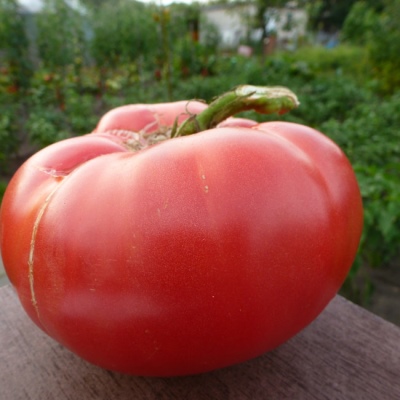
- Authors: Ugarova S.V., Dederko V.N., Postnikova T.N.
- Year of approval: 2007
- Category: grade
- Growth type: indeterminate
- Appointment: fresh consumption
- Ripening period: mid-season
- Ripening time, days: 100-115
- Growing conditions: for open ground, for film greenhouses
- Transportability: Yes
- Leaves: medium, green
When planting tomatoes, many gardeners prefer large-fruited species with medium early ripening periods. These include the tomato variety Russian Soul, which grows both in the garden bed and under film shelters.
Breeding history
The Russian soul tomato was bred by Siberian agrobiologists S.V. Ugarova, T.N. Postnikova and V.N.Dederko in 2003. The tomato was added to the State Register of Breeding Achievements of the Russian Federation in 2007. Tomatoes are recommended for growing in all regions of the country. In the central and southern parts, the culture is planted in beds, in the northern regions - in greenhouses or under a film.
Description of the variety
The Russian soul is a tall plant, stretching up to 160-180 cm in height, of an indeterminate type. The bush is characterized by a strong central stem, medium thick green leaves, semi-spreading branches, a powerful root system and intermediate inflorescences. In each fruit cluster, 3-6 tomatoes are tied.
During the growing period, the bushes need to be formed in 1-2 stems in greenhouses, and in 2-3 - in the beds, tied to supports or trellises, and also regularly remove new stepchildren. It is not necessary to thin out the foliage, since no special thickening is observed. The variety has a universal purpose, so tomatoes are eaten fresh, added to salads, pickled, processed into drinks and dressings. Tomatoes are not suitable for whole-fruit canning due to the weight of the berries.
The main qualities of the fruit
The Russian soul tomato belongs to the group of large-fruited nightshades. Under favorable conditions, the vegetable gains weight from 256 to 600-900 grams. The shape of the berries is round with a slight ribbing. A ripe giant tomato is covered with a rich red color, and at the stage of technical maturity, the vegetable has a light green color without darkening at the stalk. The skin of the vegetable is firm, shiny, but not tough.
Tomatoes are characterized by resistance to cracking, good transport tolerance and long shelf life. Only overripe tomatoes can crack.
Taste characteristics
Tomatoes have excellent taste. The light-scarlet flesh is dense, tender, fleshy and very juicy, containing a small amount of seeds. The taste is harmonious and full-bodied, where there is both sourness and sweetness. The vegetable has a classic aroma - spicy.
Ripening and fruiting
The Russian soul tomato is mid-season. Less than 4 months pass from the mass germination of sprouts to ripe berries on the bushes - 100-115 days. Tomatoes are ripened gradually. You can taste vegetables in July. The peak of fruiting occurs in the second half of July - August.
Yield
The tomato yield is good, the main thing is to fulfill all agrotechnical requirements. On average, 7.8 kg of ripe tomatoes can be grown and harvested per 1 m2 per season.
The timing of planting seedlings and planting in the ground
The culture is grown through seedlings. Seeds are sown from mid-March, after having sorted them out and disinfected. To accelerate germination, it is recommended to cover the seedlings with glass or polyethylene. Germination begins on the 5-7th day. At the stage of growth of 3 real leaves, the bushes are seated in separate cups, which will help strengthen the root system.After diving, watering is carried out and fertilizers are applied. A week before transplanting, you need to prepare the bushes using daily hardening.
You can transplant the bushes to a permanent place at the age of 60-65 days, when the plant has 4-6 leaves and one flower brush. Seedlings are planted in the garden on a cloudy day. Often, the planting of bushes is carried out at the end of May.

Growing tomato seedlings is an extremely important process, because it largely depends on whether the gardener will be able to harvest at all. All aspects must be taken into account, from seedbed preparation to planting in the ground.
Landing scheme
Planting tomato bushes correctly in your garden is just as important as providing proper care. It is recommended to plant 3-4 tomato bushes per 1 m2. The optimal layout for planting is 50x50 cm.

Growing and care
The nightshade culture is absolutely unpretentious to care for. It is productive, growing in loose, moist, air-permeable fertile soils with neutral acidity. The tomato area must be free of weeds and grass, and also sufficiently lit.
When growing tomatoes, you should water them with settled water, apply top dressing, form, pinch and tie bushes, and also protect them from viruses and pests. In the greenhouse, you need to control the humidity level by regularly ventilating the room.




A plant needs different micronutrients at each stage of growth. All fertilizers can be divided into two groups: mineral and organic. Folk remedies are often used: iodine, yeast, bird droppings, eggshells.
It is important to observe the rate and period of feeding. This also applies to folk remedies and organic fertilizers.
Disease and pest resistance
The plant's strong immunity is able to protect it from standard diseases - fusarium wilting, cladosporium and alternaria. During the epidemic, preventive treatments will be required to prevent late blight and apical rot. Dangerous pests for Russian soul tomatoes are whiteflies, scoops, aphids and ticks.


Resistant to adverse weather conditions
Tomatoes have excellent stress resistance, so they are not afraid of temperature fluctuations, minor cold snaps, short drought and heat. In addition, the cultivar is not afraid of short shading.

























































































